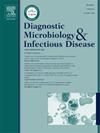The emerging clinical relevance of enterococcus gallinarum: A roadmap for future research and diagnostics
IF 1.8
4区 医学
Q3 INFECTIOUS DISEASES
Diagnostic microbiology and infectious disease
Pub Date : 2025-09-09
DOI:10.1016/j.diagmicrobio.2025.117104
引用次数: 0
Abstract
Enterococcus gallinarum is an underdiagnosed yet clinically significant opportunistic pathogen exhibiting growing concerns in antimicrobial resistance and pathogenicity. Initially regarded as a commensal of the gastrointestinal tract, E. gallinarum has emerged as a causative agent of life-threatening infections such as bacteremia, meningitis, endocarditis, and peritonitis, particularly in immunocompromised individuals. A key factor in the pathogenicity of E. gallinarum is its ability to form biofilms, a mechanism that enhances its resistance to antibiotics (vancomycin resistance) and host immune responses. The bacterium’s genetic adaptability, efflux pumps, and enzyme-mediated resistance further complicate treatment regimens, necessitating alternative therapeutic strategies. Given the increasing prevalence of multidrug-resistant enterococci, enhanced surveillance, precise diagnostic techniques, and innovative therapeutic approaches are critical to managing E. gallinarum infections. Transmission via contaminated poultry, seafood, and environmental vectors underscores its zoonotic potential, necessitating stringent food safety protocols. Current therapeutic strategies are failing due to rising resistance limits. Innovative approaches like nanoparticles, bacteriophage therapy, plant-derived compounds and immunomodulatory agents show promise in overcoming resistance and biofilm-related challenges. Artificial Intelligence and computational biology-driven drug discovery offer novel avenues for precision targeting. Diagnostic hurdles, including misidentification and underreporting, highlight the need for advanced molecular techniques and surveillance. Future research should focus on targeted therapies and vaccine development to mitigate the clinical burden of this pathogen. This review delves into the epidemiology, pathogenesis, virulence factors, drug resistance mechanisms and novel treatment modalities of E. gallinarum.
鸡肠球菌新出现的临床相关性:未来研究和诊断的路线图
鸡肠球菌(Enterococcus gallinarum)是一种未被诊断但临床上重要的机会性病原体,在抗菌素耐药性和致病性方面日益受到关注。最初被认为是胃肠道的共生体,鸡肠杆菌已成为危及生命的感染的病原体,如菌血症、脑膜炎、心内膜炎和腹膜炎,特别是在免疫功能低下的个体中。鸡大肠杆菌致病性的一个关键因素是其形成生物膜的能力,这是一种增强其对抗生素(万古霉素耐药性)和宿主免疫反应的机制。细菌的遗传适应性、外排泵和酶介导的耐药性进一步使治疗方案复杂化,需要替代治疗策略。鉴于耐多药肠球菌日益流行,加强监测、精确诊断技术和创新治疗方法对于控制鸡肠球菌感染至关重要。通过受污染的家禽、海产品和环境媒介传播凸显了其人畜共患的可能性,需要严格的食品安全规程。目前的治疗策略由于不断上升的耐药性限制而失败。纳米颗粒、噬菌体疗法、植物源性化合物和免疫调节剂等创新方法有望克服耐药性和生物膜相关挑战。人工智能和计算生物学驱动的药物发现为精确靶向提供了新的途径。诊断障碍,包括误诊和漏报,突出表明需要先进的分子技术和监测。未来的研究应侧重于靶向治疗和疫苗开发,以减轻该病原体的临床负担。本文综述了鸡大肠杆菌的流行病学、发病机制、毒力因素、耐药机制和新的治疗方法。
本文章由计算机程序翻译,如有差异,请以英文原文为准。
求助全文
约1分钟内获得全文
求助全文
来源期刊
CiteScore
5.30
自引率
3.40%
发文量
149
审稿时长
56 days
期刊介绍:
Diagnostic Microbiology and Infectious Disease keeps you informed of the latest developments in clinical microbiology and the diagnosis and treatment of infectious diseases. Packed with rigorously peer-reviewed articles and studies in bacteriology, immunology, immunoserology, infectious diseases, mycology, parasitology, and virology, the journal examines new procedures, unusual cases, controversial issues, and important new literature. Diagnostic Microbiology and Infectious Disease distinguished independent editorial board, consisting of experts from many medical specialties, ensures you extensive and authoritative coverage.

 求助内容:
求助内容: 应助结果提醒方式:
应助结果提醒方式:


